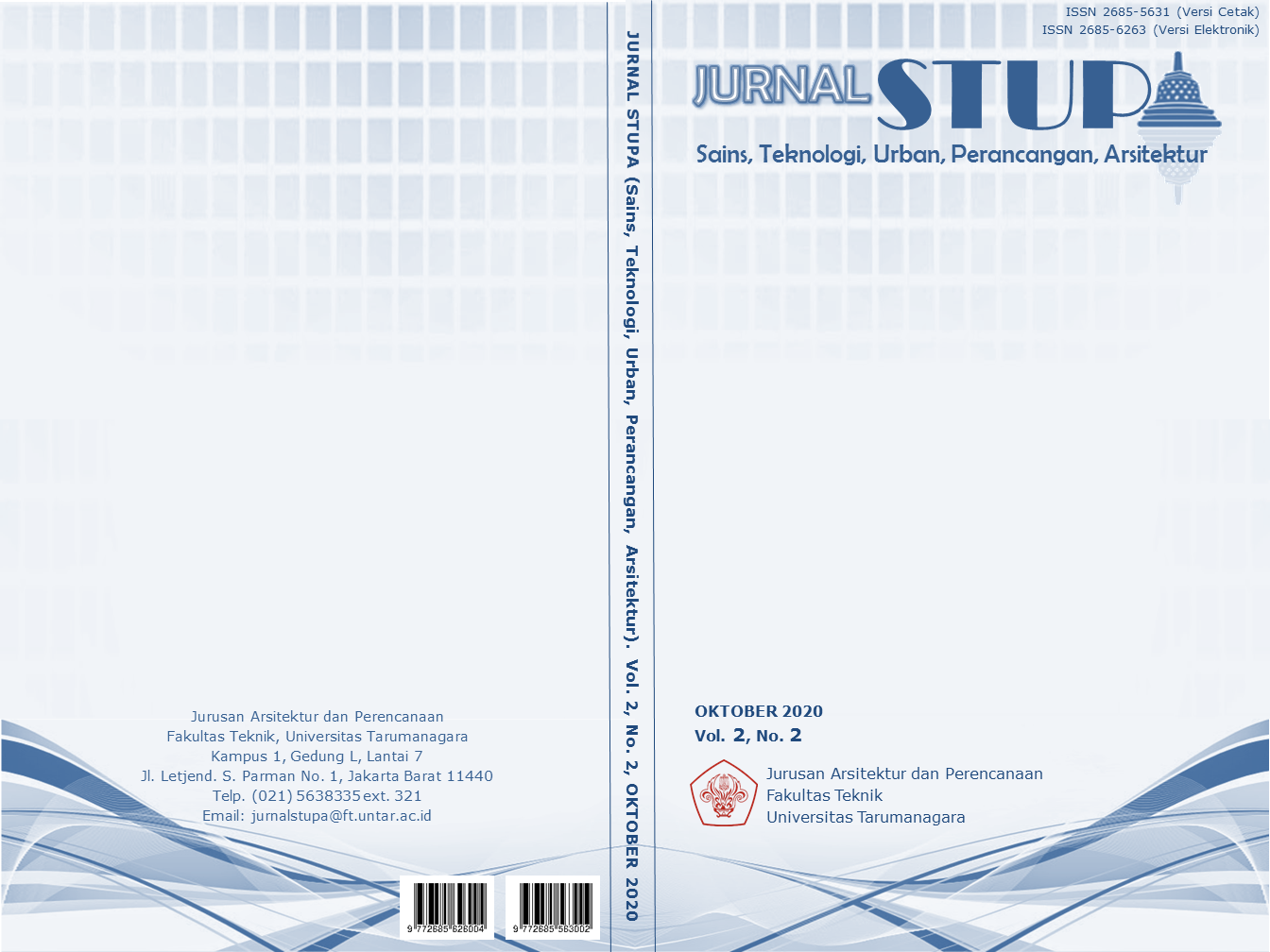SIMPUL TEKNOLOGI AKTIF DAN KREATIF
Main Article Content
Abstract
Living and growing up in urban areas with various pressures, both from home or work/school, makes people have a higher stress level. People whom lives in the city need a space in between home (first place) and a place of work / study (second place), namely the third place. Third place is important for the people because it is a place where they can be themselves, freely channel their talents and interests, as well as socializing and maintaining fitness in the midst of the busy city. Therefore, a need rises for an architectural manifestation in the form of a third place with a creative hub to channel ideas, creativity, talents, and interests and active space to maintain fitness, socialize, and build community. Penjaringan is also home to various types of communities, ranging from people with gardening activity units communities. The location of the site which is located in Penjaringan surrounded by agribusiness industrial buildings, and residential areas makes the Active Creative Technology Hub a strategic third place and able to accommodate various needs of the third activities of Penjaringan community and its surroundings. The design methodology used is trans-programming method by Bernard Tshumi which places two programmes that are not normally associated with each other together. Active Creative Technology Hub as a third place project is designed to be a place for sustainable community development, a place in between for the people of Penjaringan, and to make the environment more lively and pleasant.
Keywords: Active; Activity; Community; Creative; Social
Abstrak
Tinggal di daerah kota membuat masyarakat memiliki tingkat stres yang tinggi yang disebabkan oleh berbagai tekanan, baik dari rumah maupun tempat kerja atau sekolah. Masyarakat kota membutuhkan ruang antara tempat tinggal (first place) dan tempat kerja/ belajar (second place) yaitu third place. Kehadiran sebuah third place penting bagi masyarakat kota untuk menjadi tempat di mana mereka bisa menjadi diri sendiri, bebas menyalurkan bakat dan minat. Oleh karena itu, muncul kebutuhan akan sebuah perwujudan arsitektur berupa third place dengan creative hub untuk menyalurkan ide, kreativitas, bakat, dan minat serta active space untuk menjaga kebugaran, bersosialisasi, dan membangun komunitas. Kelurahan Penjaringan merupakan wilayah bagian dari Jakarta Utara yang berkembang dan memiliki kawasan yang sangat ramai. Selain itu di Kelurahan Penjaringan juga terdapat kawasan rumah tinggal dengan keterbatasan lahan sehingga tidak ada wadah bagi kegiatan hobi dari masyarakat. Lokasi tapak juga dikelilingi oleh bangunan dengan fungsi industri terkait mesin terkait agrobisnis, termasuk industri berskala kecil yang dijalankan oleh masyarakat sekitar. Metode perancangan yang digunakan adalah metode trans-programming oleh Bernard Tschumi yang mengkombinasikan dua program yang sifat dan konfigurasi spasialnya berbeda tanpa melihat kecocokannya. Proyek Simpul Teknologi Aktif & Kreatif sebagai sebuah third place berusaha untuk menjadi wadah bagi pembangunan komunitas, sebagai pendukung bagi masyarakat sekitar melalui penyediaan fasilitas edukatif, menjadi tempat perantara bagi masyarakat Kelurahan Penjaringan, serta membuat suasana semakin hidup dan menyenangkan.
Article Details
References
Anonim. (2019a). Tersedia di: www.tschumi.com. Diakses tanggal 30 Januari 2020.
Anonim. (2019b). Tersedia di: www.wikipedia.org/wiki/bernard tschumi.hmtl. Diakses tanggal 30 Januari 2020.
Anonim. (2019). Ekonomi Kreatif: Pengertian, Ciri-Ciri, Jenis, dan Perkembangannya. Diakses pada 25 Januari 2020, dari https://www.maxmanroe.com/vid/bisnis/ekonomi-kreatif.html.
Anwar, F. (2017). Ini Sebabnya Hidup di Perkotaan Rentan Memicu Stres. Diakses pada 28 Januari 2020, dari https://health.detik.com/berita-detikhealth/d-3473095/ini-sebabnya-hidup-di-perkotaan-rentan-memicu-stres.
Butler, S. M. & Diaz, C. (2016). “Third Places” as Community Builders. Diakses pada 24 Januari 2020, dari https://www.brookings.edu/blog/up-front/2016/09/14/third-places-as-community-builders/.
European Creative Hub Network. (2016). How to Set Up a Creative Hub. Diakses pada 28 Januari 2020, dari http://creativehubs.net/tools/Creative-Hubs-Madrid-Toolkit_Final.pdf.
Heimsath, C. (1998). Behavioral Architecture. US: McGraw-Hill.
Indriani, R. (2017). Ini Penyebab Masyarakat Kota Alami Tingkat Stres Tertinggi. Diakses pada 28 Januari 2020, dari https://www.suara.com/lifestyle/2017/04/12/170749/ini-penyebab-masyarakat-kota-alami-tingkat-stres-tertinggi.
Jerobisonif, A. (2011). Aplikasi Desain Ekologis dalam Karya Arsitektur Ken Yeang. Tesis. Jogyakarta: Teknik Arsitektur, UGM.
Kementerian Komunikasi dan Informatika RI. (2015). Ekonomi Kreatif adalah Pilar Perekonomian Masa Depan. Diakses pada 28 Januari 2020, dari https://kominfo.go.id/content/detail/5277/ekonomi-kreatif-adalah-pilar-perekonomian-masa-depan/0/berita.
McLaren, D. & Agyeman, J. (2015). Sharing Cities: A Case for Truly Smart and Sustainable Cities. US: MIT Press.
Oldenburg, R. (1989). The Great Good Place. US: Paragon House.
Peterson, C. (2009). Happy Places: Third Places. dalam https://www.psychologytoday.com/us/blog/the-good-life/200912/happy-places-third-places, diakses pada 24 Januari 2020.
Tschumi, B. (2005). Event-Cities 3 Concept vs. Context vs. Content. US: MIT Press.
Tuan, Y. F. (1977). Space and Place: The Perspective of Experience. US: University of Minnesota Press.



